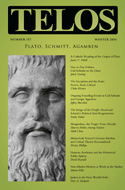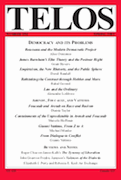By David Randall · Wednesday, January 11, 2012 David Randall’s “Humean Aesthetics and the Rhetorical Public Sphere” appears in Telos 157 (Winter 2011). Read the full version online at the TELOS Online website, or purchase a print copy of the issue here.
 This article aims to locate in the writings of David Hume the rhetorical aesthetics and philosophy of judgment that, under the name of “the conversable world,” constituted, in its essentials, the discursive, political, and moral project of Jürgen Habermas’s public sphere. Here the idea of the public sphere was shorn of the Kantian imperative to reason. Instead, Hume’s “conversable world” registered rhetorical assumptions—the key words reflecting the influence of rhetoric, and departing from Kantian strictures, were “disposition,” “pleasure,” and “best manner.” The existence of this Humean rhetorical aesthetics, as capable as Kant’s rationalizing aesthetics to claim itself as representative of the bourgeois public sphere, allows for the displacement of Kant’s aesthetics, in its historical aspect, from the conception of the public sphere. Humean rhetorical aesthetics, in turn, provide the essential historical component for the various ahistorical rhetorical critiques and revisions of Habermas’s public sphere theory, and of his philosophy writ large. It also allows for the formulation of what we may call a Humean public sphere. In contradistinction to the Kantian public sphere, the rhetorical philosophy of Hume associated the public sphere with a very different standard of judgment, a very different aesthetics, and a very different approach to teleology. This article aims to locate in the writings of David Hume the rhetorical aesthetics and philosophy of judgment that, under the name of “the conversable world,” constituted, in its essentials, the discursive, political, and moral project of Jürgen Habermas’s public sphere. Here the idea of the public sphere was shorn of the Kantian imperative to reason. Instead, Hume’s “conversable world” registered rhetorical assumptions—the key words reflecting the influence of rhetoric, and departing from Kantian strictures, were “disposition,” “pleasure,” and “best manner.” The existence of this Humean rhetorical aesthetics, as capable as Kant’s rationalizing aesthetics to claim itself as representative of the bourgeois public sphere, allows for the displacement of Kant’s aesthetics, in its historical aspect, from the conception of the public sphere. Humean rhetorical aesthetics, in turn, provide the essential historical component for the various ahistorical rhetorical critiques and revisions of Habermas’s public sphere theory, and of his philosophy writ large. It also allows for the formulation of what we may call a Humean public sphere. In contradistinction to the Kantian public sphere, the rhetorical philosophy of Hume associated the public sphere with a very different standard of judgment, a very different aesthetics, and a very different approach to teleology.
Continue reading →
By David Randall · Friday, April 15, 2011 David Randall’s “Empiricism, the New Rhetoric, and the Public Sphere” appears in Telos 154 (Spring 2011). Read the full version at TELOS Online website.
 Jürgen Habermas’s conception of the early modern public sphere derived in good part from a Kantian epistemology and the corollary Kantian theory of communication. Yet we can, and should, instead conceive of the public sphere as rhetorical in nature, and therefore substitute a rhetorical epistemology and theory of communication for the Kantian equivalents that underpin Habermas’s account. But if rhetoric is to be substituted for Kantian reason in an account of the early modern public sphere, one must argue the existence of an intellectual tradition of rhetorical philosophy concurrent with and parallel to that of Habermas’s Kantian tradition, and equally able to claim itself both representative of the thought of the age and indicative of the thought and practice of the multitude. This historically situated rhetorical philosophy did exist. The empirical tradition itself, from Locke through Hume, preserved an astonishing amount of rhetorical thought. Secondly, the tradition of New Rhetoric, as exemplified by figures such as Adam Smith, George Campbell, and Hugh Blair, reconceived rhetoric around empirical epistemology. The intellectual tradition that leads from Locke, through Hume, to George Campbell has as much claim as the Kantian tradition to articulate, and represent, the practice of the early modern public sphere. Jürgen Habermas’s conception of the early modern public sphere derived in good part from a Kantian epistemology and the corollary Kantian theory of communication. Yet we can, and should, instead conceive of the public sphere as rhetorical in nature, and therefore substitute a rhetorical epistemology and theory of communication for the Kantian equivalents that underpin Habermas’s account. But if rhetoric is to be substituted for Kantian reason in an account of the early modern public sphere, one must argue the existence of an intellectual tradition of rhetorical philosophy concurrent with and parallel to that of Habermas’s Kantian tradition, and equally able to claim itself both representative of the thought of the age and indicative of the thought and practice of the multitude. This historically situated rhetorical philosophy did exist. The empirical tradition itself, from Locke through Hume, preserved an astonishing amount of rhetorical thought. Secondly, the tradition of New Rhetoric, as exemplified by figures such as Adam Smith, George Campbell, and Hugh Blair, reconceived rhetoric around empirical epistemology. The intellectual tradition that leads from Locke, through Hume, to George Campbell has as much claim as the Kantian tradition to articulate, and represent, the practice of the early modern public sphere.
Continue reading →
|
|
 This article aims to locate in the writings of David Hume the rhetorical aesthetics and philosophy of judgment that, under the name of “the conversable world,” constituted, in its essentials, the discursive, political, and moral project of Jürgen Habermas’s public sphere. Here the idea of the public sphere was shorn of the Kantian imperative to reason. Instead, Hume’s “conversable world” registered rhetorical assumptions—the key words reflecting the influence of rhetoric, and departing from Kantian strictures, were “disposition,” “pleasure,” and “best manner.” The existence of this Humean rhetorical aesthetics, as capable as Kant’s rationalizing aesthetics to claim itself as representative of the bourgeois public sphere, allows for the displacement of Kant’s aesthetics, in its historical aspect, from the conception of the public sphere. Humean rhetorical aesthetics, in turn, provide the essential historical component for the various ahistorical rhetorical critiques and revisions of Habermas’s public sphere theory, and of his philosophy writ large. It also allows for the formulation of what we may call a Humean public sphere. In contradistinction to the Kantian public sphere, the rhetorical philosophy of Hume associated the public sphere with a very different standard of judgment, a very different aesthetics, and a very different approach to teleology.
This article aims to locate in the writings of David Hume the rhetorical aesthetics and philosophy of judgment that, under the name of “the conversable world,” constituted, in its essentials, the discursive, political, and moral project of Jürgen Habermas’s public sphere. Here the idea of the public sphere was shorn of the Kantian imperative to reason. Instead, Hume’s “conversable world” registered rhetorical assumptions—the key words reflecting the influence of rhetoric, and departing from Kantian strictures, were “disposition,” “pleasure,” and “best manner.” The existence of this Humean rhetorical aesthetics, as capable as Kant’s rationalizing aesthetics to claim itself as representative of the bourgeois public sphere, allows for the displacement of Kant’s aesthetics, in its historical aspect, from the conception of the public sphere. Humean rhetorical aesthetics, in turn, provide the essential historical component for the various ahistorical rhetorical critiques and revisions of Habermas’s public sphere theory, and of his philosophy writ large. It also allows for the formulation of what we may call a Humean public sphere. In contradistinction to the Kantian public sphere, the rhetorical philosophy of Hume associated the public sphere with a very different standard of judgment, a very different aesthetics, and a very different approach to teleology.  Jürgen Habermas’s conception of the early modern public sphere derived in good part from a Kantian epistemology and the corollary Kantian theory of communication. Yet we can, and should, instead conceive of the public sphere as rhetorical in nature, and therefore substitute a rhetorical epistemology and theory of communication for the Kantian equivalents that underpin Habermas’s account. But if rhetoric is to be substituted for Kantian reason in an account of the early modern public sphere, one must argue the existence of an intellectual tradition of rhetorical philosophy concurrent with and parallel to that of Habermas’s Kantian tradition, and equally able to claim itself both representative of the thought of the age and indicative of the thought and practice of the multitude. This historically situated rhetorical philosophy did exist. The empirical tradition itself, from Locke through Hume, preserved an astonishing amount of rhetorical thought. Secondly, the tradition of New Rhetoric, as exemplified by figures such as Adam Smith, George Campbell, and Hugh Blair, reconceived rhetoric around empirical epistemology. The intellectual tradition that leads from Locke, through Hume, to George Campbell has as much claim as the Kantian tradition to articulate, and represent, the practice of the early modern public sphere.
Jürgen Habermas’s conception of the early modern public sphere derived in good part from a Kantian epistemology and the corollary Kantian theory of communication. Yet we can, and should, instead conceive of the public sphere as rhetorical in nature, and therefore substitute a rhetorical epistemology and theory of communication for the Kantian equivalents that underpin Habermas’s account. But if rhetoric is to be substituted for Kantian reason in an account of the early modern public sphere, one must argue the existence of an intellectual tradition of rhetorical philosophy concurrent with and parallel to that of Habermas’s Kantian tradition, and equally able to claim itself both representative of the thought of the age and indicative of the thought and practice of the multitude. This historically situated rhetorical philosophy did exist. The empirical tradition itself, from Locke through Hume, preserved an astonishing amount of rhetorical thought. Secondly, the tradition of New Rhetoric, as exemplified by figures such as Adam Smith, George Campbell, and Hugh Blair, reconceived rhetoric around empirical epistemology. The intellectual tradition that leads from Locke, through Hume, to George Campbell has as much claim as the Kantian tradition to articulate, and represent, the practice of the early modern public sphere. 

